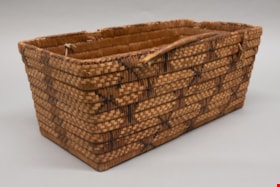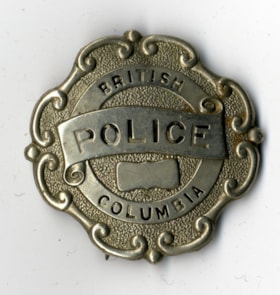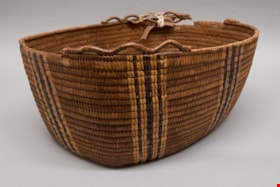Narrow Results By
Person / Organization
- British Columbia Ferry Services Incorporated 1
- British Columbia Provincial Police
- Burnaby Village Museum 2
- Canada Summer Games 1
- Century Park Museum Association 2
- C.W. Parker Company 1
- Girl Guides of Canada 2
- Henderson, Vivian 1
- Hill, Annie Sara Kenrick 2
- Hill, Louis Claude "Claude"
- Hurren, Anthony R. 1
- Lower Mainland Association of the Friends of the Vancouver Carousel 1
carrying basket
https://search.heritageburnaby.ca/link/museumartifact80210
- Repository
- Burnaby Village Museum
- Accession Code
- BV009.1.1
- Description
- Rectangular coiled cedar root basket with cedar slat foundation and walls that flare slightly towards rim. Decorated in beaded designs of cattail grass and black dyed cherry bark. Darker elements arranged in a butterfly design. Butterflies are said to represent everlasting life by Stó:lō and Nlaka’pamux basket makers. Overcast handles sewn to basket with leather ties. One has been repaired with string. Finished with a braided rim. Triangular shaped stitches attach base to walls of basket. Interior Salish: Stl’atl’imx?
- Object History
- Basket, ca. 1895-1910, from the collection of the L. Claude Hill family, who owned the property that became the Burnaby Village Museum. According to the Hill family, L. Claude's wife Anne Sarah Hill (nee Kendrick) traded blankets for baskets, although it is not known if this particular basket was obtained in this manner. Indigenous people travelled the trail that crossed Deer Lake Brook (Douglas Road / Canada Way).
- Measurements
- Measurements: width 24 cm and length 44 cm and depth 18 cm. All measured from top edge to outside.
- Country Made
- Canada
- Province Made
- British Columbia
- School/Style
- Coast Salish
- Culture
- Stl’atl’imx
Images
Documents
police badge
https://search.heritageburnaby.ca/link/museumartifact48349
- Repository
- Burnaby Village Museum
- Accession Code
- BV005.18.4
- Description
- British Columbia Provincial Police badge (# 678). It is silver-coloured and has geometic line shapes bordering a circle with engraving. An engraved banner crosses the circle. The obverse pattern is visible on the reverse.
- Object History
- This item was a gift to Donald Brown. In 1947, Don left the army to join the ranks of the British Columbia Provincial Police force – embarking on a three-decade long career. His first assignment brought him to the city that he would eventually adopt as home – Burnaby – and he served here from 1947-1954, first as a member of the BC Police Department and then as a Royal Canadian Mounted Policeman after the Provincial force was absorbed by their federal counterparts, the RCMP. In 1954, Don was transferred to Regina, Saskatchewan and then on to Ottawa, Ontario to serve in the Crime Detection Laboratories. After a year and a half spent in training, he became qualified as an Examiner of Questioned Documents and travelled extensively throughout Ontario and Quebec, providing expert testimony in such matters as handwriting, counterfeiting, graphic arts, alterations, etc. During this time, he also attained the rank of first Corporal, and then Sergeant in the RCMP. In total, Don spent over nine years in Ottawa, and while working, managed to add to his education by taking courses from Carleton University, the RCAF and the Ottawa Teacher’s College at night. In July, 1963, Don made his way back to the West Coast when he was transferred to Vancouver to be the Second in Charge of a new laboratory and head of the Document Section. He was soon promoted to Staff Sergeant. Once again, his experience and expertise was called upon and he devoted a great deal of time to providing expert testimony in BC and the Yukon. In May of 1970, he was promoted to Sub-Inspector and was transferred to Edmonton to take command of the new Crime Detection Laboratory built to serve Alberta and the Northwest Territories. By 1972, he was promoted to full Inspector. Under his direction, the new Edmonton lab became one of the most utilised in the RCMP. Transferred back to Vancouver in 1975, Don became the Officer-in-Charge of a new Crime Laboratory and took over the National Police Services pilot project for British Columbia – overseeing work in the areas of computer sciences, laboratory, communications, records, and identification sections. He was rewarded for this work with a promotion to Superintendent in September, 1975. In 1976, after a distinguished 35 years combined service to the armed forces and the police (and a list of awards and citations including the Meritorious Service Award BCPP-1950, the Commissioner’s Commendation RCMP-1951, Chief of Police Commendation-1951, and the Canadian Centennial Medal-1967), Don retired and founded his own laboratory to carry on his work in the field of questioned documents. He supplied his services as an expert witness throughout the western provinces and added to his list of associations and awards. He became a Fellow (Emeritus) of the American Academy of Forensic Sciences, a Life Member (Emeritus) and Past Director of the Canadian Society of Forensic Sciences, a Member of the American Society of Questioned Document Examiners, and a Diplomate of the American Board of Forensic Document Examiners. It was at this point in his life, after his retirement, that Don decided to become involved in local politics and with the blessing of his wife and six children, he joined the Burnaby Voters’ Association as their Secretary and in 1978 was elected to a two-year term as a Burnaby School Trustee. After his two successful years as Trustee, he chose to run as a candidate for alderman during the next municipal election held in November of 1979. Not only did he win his seat for that election, but he was also successful in defending his position on Council during the next two elections as well, serving Burnaby as Alderman from 1979 to 1985. During this time, Don also became a member of the Community College for the Retired, the Horsemen’s Society and the Burnaby Historical Society. He has also given his support to Arts Council programs and numerous other community functions over the years. In 1991, Don was appointed as Chair of the Burnaby Centennial Committee, dedicating himself to making Burnaby’s Centennial celebration a memorable success. Throughout part of 1991 and all of 1992, Don gave his time unstintingly, often attending several meetings and/or functions a day. His contributions were always supported by his wife Helen, and their work during the Centennial Year was just one example of the strength of their 66-year partnership. They were both formally recognized for their efforts when they were chosen to receive the Kushiro Cup and named the Citizens of the Year in 1992. Also that year, Don was a recipient of the Canadian 125 Medal and one year later, in March 1993, Donald Brown was awarded Burnaby’s highest honour and was made a Freeman of the City of Burnaby.
- Marks/Labels
- "BRITISH / COLUMBIA", engraved on front "POLICE" (large), engraved on front "678", stamped on reverse
Images
work basket
https://search.heritageburnaby.ca/link/museumartifact80211
- Repository
- Burnaby Village Museum
- Accession Code
- BV009.1.2
- Description
- Oval shaped coiled cedar root basket with cedar slat foundation. Overcast rim with remnants of a loopwork border. Decorated with vertical stripes of imbricated designs in canary grass and black dyed cherry bark. Cherry bark can be distinguished by the small eyes in the surface of the bark. If the basket maker is skilled the bark has a shiny appearance, if it has not been scraped properly it has a greyish tinge. Canary grass is differentiated from cattail and bear grass by its shiny appearance according to a Stó:lō/Stl’atl’imx elder and basket maker from Mount Currie, who was married into Upper Sḵwx̱wú7mesh.
- Object History
- Basket, ca. 1895-1910, from the collection of the L. Claude Hill family, who owned the property that became the Burnaby Village Museum. According to the Hill family, L. Claude's wife Anne Sarah Hill (nee Kendrick) traded blankets for baskets, although it is not known if this particular basket was obtained in this manner. Indigenous people travelled the trail that crossed Deer Lake Brook (Douglas Road / Canada Way).
- Measurements
- Measurements: width 31.5 cm and length 51.5 cm and depth 19.5 cm all measured from top edge to outside of basket, not including trim.
- Country Made
- Canada
- Province Made
- British Columbia
- School/Style
- Coast Salish
- Culture
- First Nations


